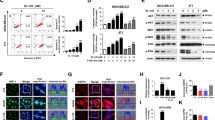Abstract
Heat shock protein 90 (Hsp90) is an attractive target for breast cancer treatment, as it is required for the proper folding and stabilization of several proteins known to be involved in breast cancer growth and development. These proteins include the epidermal growth factor receptor, human epidermal growth factor receptor 2 (HER2), estrogen receptor (ER), progesterone receptor (PR), and src. 17-Allylamino-17-demethoxygeldanamycin (17-AAG) is an intravenous Hsp90 inhibitor in development for breast cancer treatment. We conducted a phase II study of 17-AAG 220 mg/m2 on days 1, 4, 8, and 11 every 21 days in patients with metastatic and locally advanced breast cancer. Since we expected the molecular effects of Hsp90 inhibition to extend beyond just ER, PR, and HER2 down regulation and to impact a variety of other cellular proteins, patients were not selected based on ER, PR, or HER2 status. Eleven patients, including 6 patients with triple negative breast cancer, were enrolled and treated. There were no responses and 3 patients had stable disease as their best response. Five patients developed grade 3/4 toxicities, which were primarily hepatic and pulmonary. Based on these results, we do not recommend further study of 17-AAG at this dosing schedule or in unselected breast cancer patients.
Similar content being viewed by others
References
Chiosis G, Huezo H, Rosen N, Mimnaugh E, Whitesell L, Neckers L (2003) 17AAG: low target binding affinity and potent cell activity—finding an explanation. Mol Cancer Ther 2:123–129
Sausville EA (2001) Combining cytotoxics and 17-allylamino, 17-demethoxygeldanamycin: sequence and tumor biology matters. Clin Cancer Res 7:2228–2236
Young JC, Moarefi I, Hartl FU (2001) Hsp90: a specialized but essential protein-folding tool. J Cell Biol 154:267–273
Goetz MP, Toft DO, Ames MM, Erlichman C (2003) The Hsp90 chaperone complex as a novel target for cancer therapy. Ann Oncol 14:1169–1176
Yano M, Naito Z, Yokoyama M et al (1999) Expression of hsp90 and cyclin D1 in human breast cancer. Cancer Lett 137:45–51
Pick E, Kluger Y, Giltnane JM et al (2007) High HSP90 expression is associated with decreased survival in breast cancer. Cancer Res 67:2932–2937
Ramanathan RK, Trump DL, Eiseman JL et al (2005) Phase I pharmacokinetic-pharmacodynamic study of 17-(allylamino)-17-demethoxygeldanamycin (17AAG, NSC 330507), a novel inhibitor of heat shock protein 90, in patients with refractory advanced cancers. Clin Cancer Res 11:3385–3391
Goetz MP, Toft D, Reid J et al (2005) Phase I trial of 17-allylamino-17-demethoxygeldanamycin in patients with advanced cancer. J Clin Oncol 23:1078–1087
Banerji U, O’Donnell A, Scurr M et al (2005) Phase I pharmacokinetic and pharmacodynamic study of 17-allylamino, 17-demethoxygeldanamycin in patients with advanced malignancies. J Clin Oncol 23:4152–4161
Solit DB, Ivy SP, Kopil C et al (2007) Phase I trial of 17-allylamino-17-demethoxygeldanamycin in patients with advanced cancer. Clin Cancer Res 13:1775–1782
Grem JL, Morrison G, Guo XD et al (2005) Phase I and pharmacologic study of 17-(allylamino)-17-demethoxygeldanamycin in adult patients with solid tumors. J Clin Oncol 23:1885–1893
Weigel BJ, Blaney SM, Reid JM et al (2007) A phase I study of 17-allylaminogeldanamycin in relapsed/refractory pediatric patients with solid tumors: a Children’s Oncology Group study. Clin Cancer Res 13:1789–1793
Bagatell R, Gore L, Egorin MJ et al (2007) Phase I pharmacokinetic and pharmacodynamic study of 17-N-allylamino-17-demethoxygeldanamycin in pediatric patients with recurrent or refractory solid tumors: a pediatric oncology experimental therapeutics investigators consortium study. Clin Cancer Res 13:1783–1788
Ramanathan RK, Egorin MJ, Eiseman JL et al (2007) Phase I and pharmacodynamic study of 17-(allylamino)-17-demethoxygeldanamycin in adult patients with refractory advanced cancers. Clin Cancer Res 13:1769–1774
Nowakowski GS, McCollum AK, Ames MM et al (2006) A phase I trial of twice-weekly 17-allylamino-demethoxy-geldanamycin in patients with advanced cancer. Clin Cancer Res 12:6087–6093
Nawaz Z, Lonard DM, Dennis AP, Smith CL, O’Malley BW (1999) Proteasome-dependent degradation of the human estrogen receptor. Proc Natl Acad Sci USA 96:1858–1862
Bagatell R, Khan O, Paine-Murrieta G, Taylor CW, Akinaga S, Whitesell L (2001) Destabilization of steroid receptors by heat shock protein 90-binding drugs: a ligand-independent approach to hormonal therapy of breast cancer. Clin Cancer Res 7:2076–2084
Basso AD, Solit DB, Munster PN, Rosen N (2002) Ansamycin antibiotics inhibit Akt activation and cyclin D expression in breast cancer cells that overexpress HER2. Oncogene 21:1159–1166
Munster PN, Srethapakdi M, Moasser MM, Rosen N (2001) Inhibition of heat shock protein 90 function by ansamycins causes the morphological and functional differentiation of breast cancer cells. Cancer Res 61:2945–2952
Modi S, Stopeck AT, Linden HM, et al. (2011) HSP90 inhibition is effective in breast cancer: a phase 2 trial of tanespimycin (17AAG) plus trastuzumab in patients with HER2-positive metastatic breast cancer progressing on trastuzumab. Clin Cancer Res 17: 5132–5139. http://clincancerres.aacrjournals.org/content/early/2011/05/10/1078-0432.CCR-11-0072.full.pdf
Koga F, Xu W, Karpova TS, McNally JG, Baron R, Neckers L (2006) Hsp90 inhibition transiently activates Src kinase and promotes Src-dependent Akt and Erk activation. Proc Natl Acad Sci USA 103:11318–11322
Acknowledgment
This study was funded through a grant from the National Institutes of Health, U01 CA062487.
Ethical standards
This study was performed within and conducted in compliance with the current laws of the United States of America.
Conflict of interest
Lawrence Flaherty discloses that he has participated as an advisor to Bristol-Myers Squibb in relation to other agents. The remaining authors declare that they have no conflict of interest.
Author information
Authors and Affiliations
Corresponding author
Rights and permissions
About this article
Cite this article
Gartner, E.M., Silverman, P., Simon, M. et al. A phase II study of 17-allylamino-17-demethoxygeldanamycin in metastatic or locally advanced, unresectable breast cancer. Breast Cancer Res Treat 131, 933–937 (2012). https://doi.org/10.1007/s10549-011-1866-7
Received:
Accepted:
Published:
Issue Date:
DOI: https://doi.org/10.1007/s10549-011-1866-7




